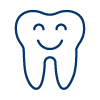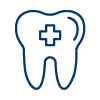Orthodontic Treatments
For All Ages
Children
There is no minimum age for your child to begin orthodontic treatment, however, the American Association of Orthodontists recommends visiting the orthodontist around age seven.
By this age, most children have a mix of baby teeth and adult teeth, making it easier for the orthodontist to diagnose and correct tooth and jaw problems before they become more severe.
Teens
Orthodontics is a big part of life for many teenagers. While braces may have had a bad reputation in the past, teens now have more choices than ever in creating a beautiful smile. From traditional braces to “invisible” aligners, the number of effective and aesthetic options is growing all the time!
Orthodontic treatment is an investment in your teen’s future. Please contact our office to schedule your complimentary orthodontic evaluation and start your smile journey!
Adults
There’s never been a better time to get the confident smile you deserve! In fact, the American Association of Orthodontists states that one in five orthodontic patients is over the age of 21.
At Cranford Orthodontics we offer a variety of braces and appliances that are comfortable, aesthetic, and customized to meet your needs. We will work with you to ensure that you receive the most appropriate treatments, and that your needs are met with understanding and respect from us.
To learn more about the benefits of adult orthodontics please contact our practice to schedule a complimentary consultation. We understand that you have a busy schedule, and we will work with you to make sure each office visit is as convenient as possible.




Phase I
Treatment

Adult
Braces

Two-Phase
Treatment

Ceramic
Braces

Invisalign

Invisalign
Teen

Surgical
Orthodontics
Technology
iTero Digital Impressions
The iTero Element scanner is a radiation-free laser that digitally captures the structure of the teeth and gums using the latest optical technology–ensuring a quick and accurate impression from the start. In addition to being a more comfortable patient experience, the digital impressions also give you the ability to see your teeth instantly in 3D; improving communication during the consultation and treatment process.
So whether you’re getting an expander, a retainer, or starting Invisalign, it’s as easy as taking a video!
Temporary Anchorage Devices
TADs are placed in the bone between the roots of teeth. Placement of TADs is minimally invasive and often completed using only topical anesthetic. There is little or no discomfort because there are no nerve endings in bone tissue. Placement of the TAD is quick, and may be over before you know it. You may feel slight pressure while the TAD is being placed, but within a day, you will no longer be able to feel it.
Your TAD is removed once your treatment is complete, or it is no longer needed to help straighten your teeth. Removal is a comfortable procedure that takes just a few minutes.
A TAD can be cleaned the same way you clean your braces — by brushing your teeth at least three times a day. If you have questions about TADs, please contact our practice. We will be able to answer any of your questions and provide you with detailed information about your orthodontic treatment.
Diode Laser Treatment
- Ideal Bracket Placement: If your gums haven’t receded properly, or a tooth is erupting slower than expected, a laser can be used to remove exceed tissue and reveal enough tooth surface to place a bracket
- Exposure of Impacted Teeth: Impacted teeth are teeth that haven’t erupted properly through the gums. By using laser treatment, we can assist a tooth’s eruption without the need to wait months for the tooth to erupt on its own or possibly avoid the need to refer for an expensive surgical procedure.
- Aesthetic Gingival Recontouring: Your gum tissue serves as a “frame” for your teeth; orthodontic lasers are used to sculpt the gums around the teeth in a way that helps improve the overall appearance of your smile. Aesthetic gingival recontouring is a procedure that reshapes the gum line to improve the aesthetics of your smile by exposing more of your teeth.
The best part of laser treatment? In most cases, there is no need for needles! We simply apply a topical anesthetic to the gum tissue being treated so all you feel is the slight movement of the laser tip.
Contact Us
Request a Complimentary Evaluation
Where to Find Us
Cranford
Cranford Orthodontics
118 North Ave West
Cranford, NJ 07016
(In the Cranford Professional Building, next to the Citgo Station)













